CliMate – real data, real change
In October 2022, Clariant unveiled a novel product carbon footprint (PCF) calculator called CliMate.


Delivering on Clariant's purpose »Greater chemistry - between people and planet.«
This story is an example of how Clariant delivers on its purpose-led strategy.
An oft-cited truism in business says that you cannot manage what you cannot measure. That is undoubtedly true for greenhouse gases (GHG). And it is one of the reasons why reliable data are so vital in the fight against climate change. Unfortunately, it takes a lot of effort to track how much of a carbon burden any specific product carries. Especially if you want to include all the emissions caused along its entire supply chain. In October 2022, Clariant unveiled its very own solution to this problem: a novel product carbon footprint (PCF) calculator called CliMate.
The new digital tool, developed in-house by Clariant, automates the calculation of PCF while also increasing their validity. »This is a big deal,« says Kattia Martinez, Portfolio Sustainability Analyst at Clariant. »As an industry first, we can now offer consistent cradle-to-gate greenhouse gas emission calculations for hundreds of finished products and solutions across our entire portfolio. And we can do so more or less at the push of a button.«
Martinez and a team of internal and external experts worked for more than a year on the tool and the underlying methodology. Both are in line with the international ISO 14067 norm on carbon footprint reporting and have been independently validated by TÜV Rheinland.
Making it count
What sets CliMate apart is that it uses information specific to both the product’s raw materials in question and its actual production parameters. For example, CliMate draws directly on the bill of materials (BOM) for the individual product and the specific type of energy used at the plant it came from. That minimizes reliance on estimates and industry averages. »Wherever possible, we base our calculations on the actual recipe,« Martinez explains. »We rely on our own data and those provided by our suppliers and specialized databases.« These inputs are updated annually and automatically, using existing GHG tracking tools and operational data on all inputs and outputs. »By using the latest bill of material available, technically it is possible to calculate the carbon footprint not only for a particular product but down to a specific batch and plant,« explains Martinez. »Over time, it will also allow us to assess our progress towards improving the GHG performance of different products and sites — information which is also interesting for our customers.« Another pioneering feature in CliMate: It takes into account the biogenic carbon uptake from bio-based materials, giving Clariant and its customers a more accurate picture of a product's true climate impact.
»As an industry first, we can now offer consistent cradle-to-gate greenhouse gas emission calculations for hundreds of finished products and solutions across our entire portfolio.«
Kattia Martinez, Portfolio Sustainability Analyst

The Pressure is on
These new insights are bound to help Clariant in reaching its climate targets. For one, greater transparency on carbon performance works to focus the company's reduction efforts more effectively. For another, it deepens Clariant's collaboration with suppliers to reduce emissions along the supply chain.
Clariant's push for transparency is part of a broader trend. An increasing number of businesses and brand owners already publish carbon footprints. Last year, the food giant Unilever announced plans to print carbon labels on all its products by around 2026. And it is not just makers of fast-moving consumer goods who feel the pressure from consumers and regulators to report ever more detailed carbon footprints and reduction targets. The European Union, for example, has laws in the works that will require businesses and manufacturers to quantify the carbon footprint of all their products. »Our customers have their own sustainability targets, and they need our help to reach them,« says Martinez. »Increasingly, they require suppliers to provide credible emissions calculations on the materials they buy.« With CliMate we are able to fulfill this.
Growing further
Since its launch, Martinez and her colleagues have been busy fielding requests from within Clariant and from customers. »Interest is growing fast as more and more people realize the possibilities CliMate offers,« she says. Meanwhile, the company's sustainability experts work to further improve and expand the tool to cover still more of Clariant's portfolio and to draw on more data made available through Clariant's supplier engagement program. »I think it's fair to say that we're setting a new standard,« says Martinez.
Clariant is a member of Together for Sustainability (TfS), a joint initiative of chemical companies promoting sustainability in the supply chain. As such, the company is helping develop guidelines on product carbon footprints and corporate emissions accounting. CliMate is Clariant's way of putting these guidelines into practice: »Making carbon footprints more transparent, more reliable, and more readily available along the entire value chain is a game changer,« Martinez says. »It allows all of us — suppliers of goods and services, manufacturers, and ultimately consumers — to make more informed decisions and fight climate change more effectively.«

